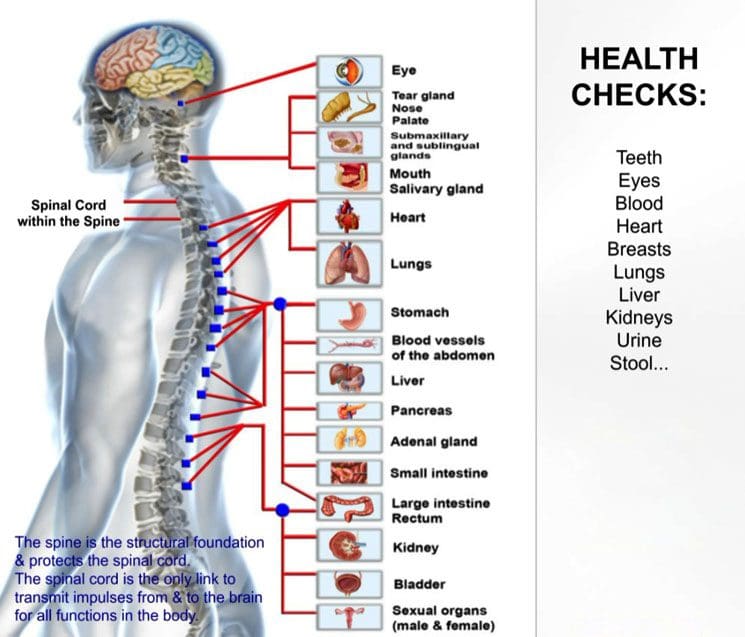Chiropractic Solutions for Constipation and Bloating Relief

Introduction: Why Spinal Health Matters for Digestion
When most people think about digestive issues like bloating or constipation, they often imagine dietary triggers—too much dairy, not enough fiber, dehydration, or food sensitivities. While these are common causes, there’s another factor that’s frequently overlooked: spinal alignment.
Your spine isn’t just a stack of bones that keeps you standing upright—it’s the protective housing for your spinal cord, a key part of your central nervous system (CNS). The CNS connects your brain to every organ in your body, including your stomach, intestines, and colon. If your spine is misaligned, it can disrupt the flow of nerve signals to your digestive organs, leading to discomfort, irregularity, and other gut-related symptoms (Medical News Today, n.d.).
This concept is not theoretical—it’s something chiropractors and integrative medicine practitioners see every day. A patient might come in for back pain but leave with improved digestion after their spinal alignment is corrected. The reason? Chiropractic care doesn’t just work on muscles and joints—it supports the nervous system, which in turn helps regulate digestive function (Bronson Heritage Chiropractic, n.d.).
Dr. Alexander Jimenez, DC, APRN, FNP-BC, a chiropractor and nurse practitioner in El Paso, has seen this connection in hundreds of patients. “When we restore proper spinal alignment,” he notes, “we’re not just improving posture—we’re improving communication between the brain and the rest of the body, and that includes the digestive system.”
How Spinal Misalignment Impacts Digestive Function
The digestive system works in a coordinated rhythm. Food moves from the stomach into the small intestine, where nutrients are absorbed, and then into the large intestine, where water is absorbed and waste is prepared for elimination. This process depends heavily on signals from the nervous system.
When vertebrae in your spine are out of place—what chiropractors call subluxations—the nerve signals between your brain and your digestive organs can be disrupted. For example:
- Thoracic spine misalignments (mid-back) may affect the nerves that control the stomach and small intestine, leading to slowed digestion or bloating.
- Lumbar spine misalignments (lower back) can interfere with nerve signals to the large intestine, potentially causing constipation.
- Cervical spine misalignments (neck) may impact the vagus nerve, which plays a major role in digestion and gut motility.
When these nerves are compressed or irritated, they can send “mixed signals” to your gut. The result? Food might move too slowly, nutrients may not be absorbed efficiently, and bowel movements can become irregular (Spring Hill Premier Chiro, n.d.).
Dr. Jimenez points out that in many personal injury cases—especially after motor vehicle accidents—patients develop both musculoskeletal pain and unexplained digestive problems. Imaging often reveals spinal misalignments in the same areas that control digestive function. Correcting these issues can significantly improve both pain and gut symptoms.
(Family Chiropractic Columbus, 2025).
The Gut–Brain–Spine Connection
Scientists and doctors often talk about the gut–brain axis—the constant communication between your brain and digestive system. However, the spinal cord also plays a crucial role in this process. Your brain sends messages to the gut through nerves that pass through the spine. If the spine is misaligned, it can distort or weaken those messages.
The vagus nerve, for example, helps regulate stomach acid production, muscle contractions in the intestines, and the release of digestive enzymes. A misalignment in the neck or upper back can irritate this nerve, leading to symptoms like heartburn, bloating, or sluggish digestion (Imagine Wellness Chiropractic, n.d.).
In Dr. Jimenez’s clinic, patients often report that, along with back pain relief, they notice better digestion after a few chiropractic sessions. This isn’t a coincidence—it’s the body functioning better because the nervous system is no longer being blocked by spinal misalignments (Thorburn Chiro, n.d.).
Bloating and Constipation: When the Spine Is the Culprit
Bloating and constipation are two of the most common digestive complaints in the United States. While dietary factors such as low fiber intake, dehydration, or excessive processed foods often play a role, spinal misalignment can be an under-recognized cause.
The lumbar spine—the lower portion of the back—is especially important for bowel function. Nerves that exit between the lumbar vertebrae communicate directly with the large intestine. If these vertebrae are misaligned, the nerve signals can be weakened or erratic. This disruption can slow down peristalsis, the wave-like muscle contractions that move food and waste through the intestines. Over time, this imbalance leads to constipation and the sensation of abdominal fullness or bloating (Gallatin Disc Center, n.d.).
It’s not just the lower spine that can play a role. The upper cervical spine—the top two vertebrae in the neck—can influence digestion via the vagus nerve. This nerve is a key component of the parasympathetic nervous system, which promotes “rest-and-digest” activity. Misalignment here can trigger issues like constipation, indigestion, and bloating (Roseville Blair Chiro, n.d.).
Dr. Jimenez recalls a patient—a 42-year-old office worker—who had suffered from chronic constipation for over five years. Despite dietary changes and over-the-counter remedies, her symptoms persisted. After a thorough examination, Dr. Jimenez identified misalignments in her lower lumbar spine and upper cervical region. Through a series of chiropractic adjustments and posture-corrective exercises, she experienced significant improvements in bowel regularity within two months.
(Family Chiropractic Columbus, 2025).
Chiropractic Care for Digestive Health
Chiropractic care focuses on restoring proper spinal alignment, which in turn improves nerve communication between the brain and body. This is particularly important for digestive organs, which rely on constant, clear signals to regulate muscle movement, enzyme production, and fluid balance.
A chiropractic adjustment uses precise, gentle pressure to move misaligned vertebrae back into their correct position. This relieves nerve compression, restores normal motion to the spinal joints, and allows for better nervous system function. Over time, this improved communication can help reduce digestive symptoms such as bloating, constipation, reflux, and abdominal discomfort (Parc of Ontario, n.d.).
Many patients report positive digestive changes after beginning chiropractic care—even if they didn’t originally seek treatment for gut problems. One possible reason is that improved spinal alignment allows the parasympathetic nervous system to dominate, shifting the body away from chronic “fight or flight” stress mode and into “rest and digest” mode, which is essential for healthy bowel function (Artisan Chiro Clinic, n.d.).
Dr. Jimenez frequently integrates chiropractic care with nutritional recommendations and ergonomic advice for patients whose digestive symptoms are linked to poor posture at work. This combination not only addresses spinal misalignment but also prevents future nerve irritation from recurring workplace habits.
Integrative Medicine and Gut Health
The gut is influenced by multiple factors—diet, hydration, stress, posture, and physical activity all play major roles. Dr. Jimenez’s integrative medicine approach considers all these elements. He often incorporates:
- Nutritional Counseling: Focusing on anti-inflammatory foods and adequate fiber intake to support bowel regularity.
- Stress Management: Teaching breathing exercises and mindfulness techniques to reduce nervous system tension, which can slow digestion.
- Postural Training: Helping patients adjust workstations and daily habits to minimize spinal strain.
- Rehabilitation Exercises: Strengthening core muscles to support proper spinal alignment and protect nerve function.
Scientific evidence supports this multifaceted strategy. A healthy diet can reduce gut inflammation, restore a balanced microbiome, and support optimal nerve function (Dr. Schaer Institute, n.d.).
Patients who combine chiropractic adjustments with lifestyle changes often experience faster and more lasting relief compared to those who rely on a single intervention.
Rehabilitation Strategies for Long-Term Health
Chiropractic care can be the cornerstone of a digestive health plan, but it works best when paired with other rehabilitation strategies:
- Targeted Exercise: Strengthens spinal support muscles, reducing the risk of misalignment and nerve irritation.
- Massage Therapy: Relieves muscle tension that can pull the spine out of alignment and indirectly affect nerve pathways to the gut.
- Acupuncture: Can stimulate nerve function, improve blood flow to digestive organs, and help regulate bowel movements.
- Lifestyle Coaching: Guides patients in making daily choices that support both spinal and gut health, such as proper lifting techniques and balanced meal planning.
This combined approach helps patients maintain spinal stability, reduces inflammation, and keeps the nervous system functioning optimally (Dallas Accident and Injury Rehab, n.d.).
Dr. Jimenez stresses that rehabilitation is not a “quick fix”—it’s a long-term commitment to body alignment and nervous system health. His treatment plans often include re-evaluations every few weeks, with imaging or orthopedic testing to confirm progress.
Conclusion
Spinal misalignment can cause far more than back and neck pain—it can disrupt the nerve pathways that control digestion, leading to bloating, constipation, and other gut health problems. Chiropractic care addresses these root causes by restoring alignment and optimizing nervous system function.
When combined with integrative medicine strategies—nutrition, exercise, stress management, and targeted therapies like massage or acupuncture—patients can achieve better digestive function and improved overall health.
Dr. Alexander Jimenez’s dual role as a chiropractor and nurse practitioner allows him to bridge medical and biomechanical care, providing thorough diagnostic evaluation, effective spinal treatment, and the ability to handle legal documentation for personal injury cases. His approach ensures that patients recover fully—not just symptomatically—by addressing the underlying causes of both spinal and digestive issues.
References
Artisan Chiro Clinic. (n.d.). The connection between chiropractic care and improved digestive health. Artisan Chiropractic Clinic.
Bronson Heritage Chiropractic. (n.d.). A spinal subluxation could cause intestinal problems. Bronson Heritage Chiropractic.
Dallas Accident and Injury Rehab. (n.d.). Enhance digestion with chiropractic care in Cedar Hill. Dallas Accident and Injury Rehab.
Dr. Schaer Institute. (n.d.). IBS: Healing gut. Dr. Schaer.
Family Chiropractic Columbus. (2025, March 13). Bloating, reflux, and pain: Why your spine could be the culprit. Family Chiropractic Columbus.
Gallatin Disc Center. (n.d.). Can back pain be linked to constipation?. Gallatin Disc Center.
Imagine Wellness Chiropractic. (n.d.). Gut-brain connection. Imagine Wellness Chiropractic.
Medical News Today. (n.d.). [Can spinal problems cause digestive issues?]. Medical News Today.
Parc of Ontario. (n.d.). How chiropractic care improves digestive health. Parc of Ontario.
Roseville Blair Chiro. (n.d.). The link between upper cervical misalignment and digestive issues. Roseville Blair Chiropractic.
Spring Hill Premier Chiro. (n.d.). Can chiropractic care help with digestive problems?. Spring Hill Premier Chiropractic.
Thorburn Chiro. (n.d.). Understanding the role of chiropractic care in digestive health. Thorburn Chiropractic.

